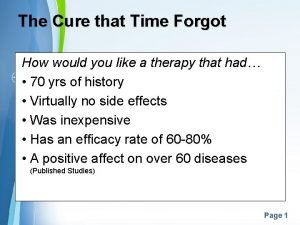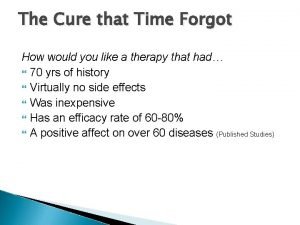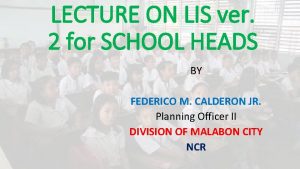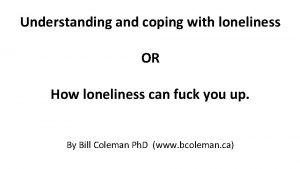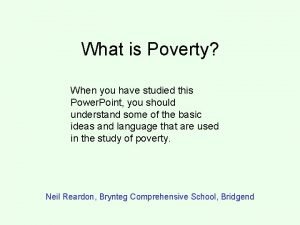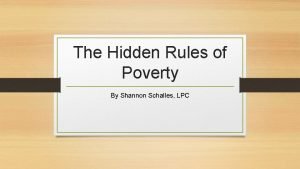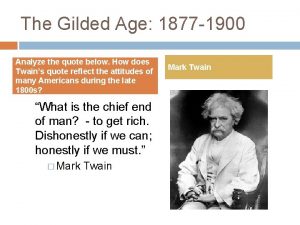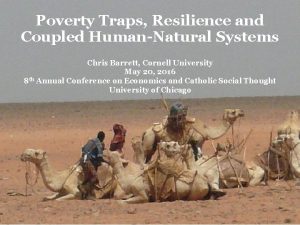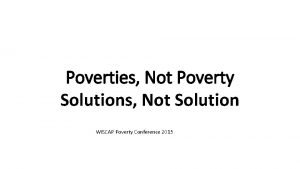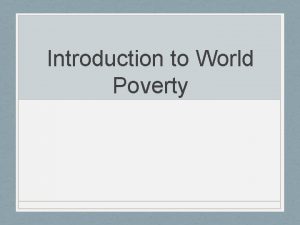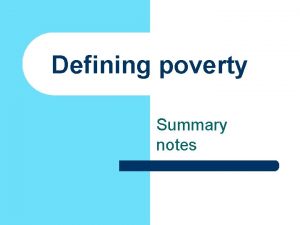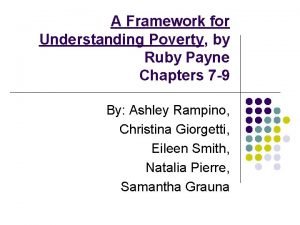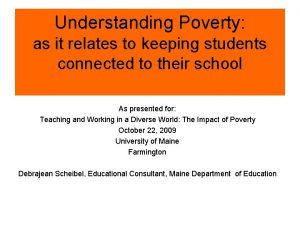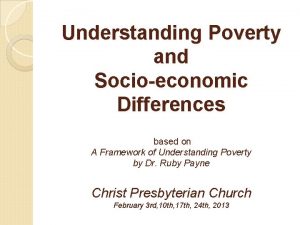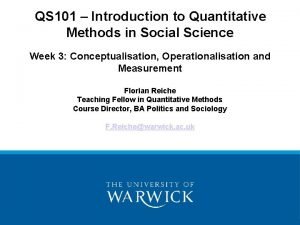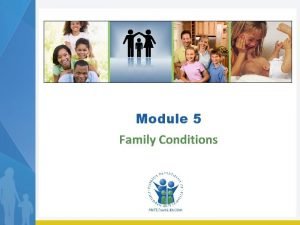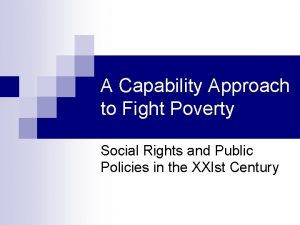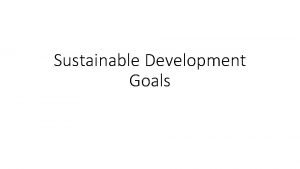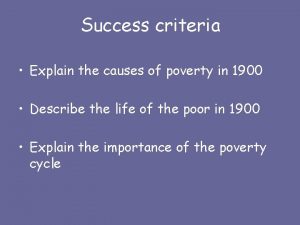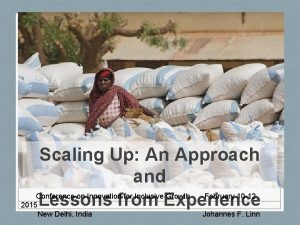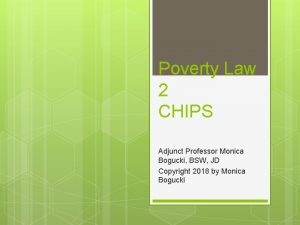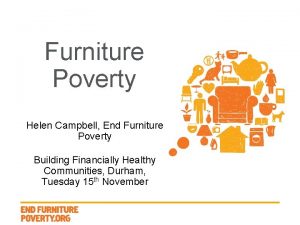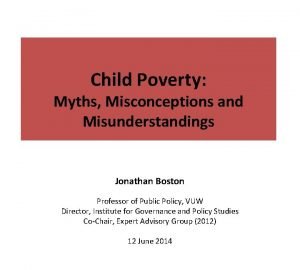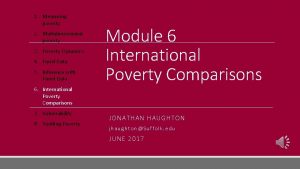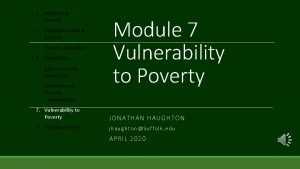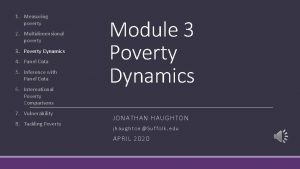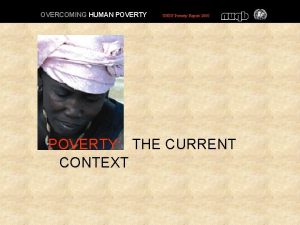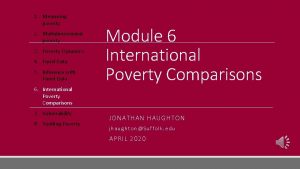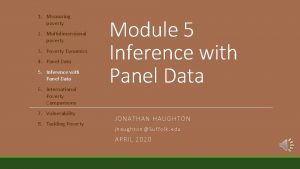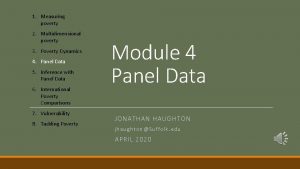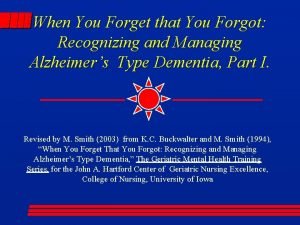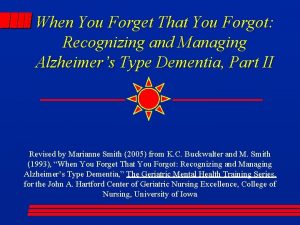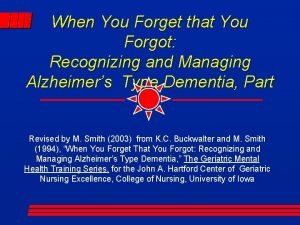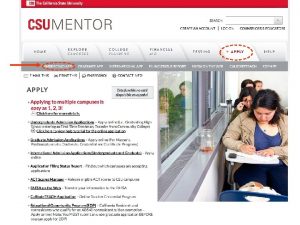Poverty issaying you forgot your lunch How do













































































- Slides: 77

Poverty is……saying you forgot your lunch.

How do you define poverty?

What should a group of aspiring teachers know about poverty?



Eric Jensen’s definition of poverty. . . Poverty is a chronic and debilitating condition that results from multiple adverse risk factors and affects the mind, body and soul.

The four primary risk factors affecting families living in poverty: Emotional and social challenges Acute and Chronic Stressors Cognitive lags Health & Safety Issues

Emotional Support A mother in poverty is less likely to provide the emotional support needed for proper developmental growth when she’s stressed about her own health, safety, bill-paying, hunger and housing prospects.

Kids from poverty get less “attunement” time attunement is the establishment of a positive, reciprocal, relationship with the primary caregiver. This “quality time” provides the basis for learning the non hard-wired socially appropriate emotions.

http: //www. youtube. com/watch? v=URpu. K g. Kt 9 kg


Emotional Impact of Low SES Children of poverty were 50% more likely to experience physical neglect and 80% more likely to report sexual abuse than those of middle to upper SES-- very stressful to them! (Hussey, Chang, & Kotch, 2006)

Understand that children raised in poverty are more likely to display: • • Acting-out behaviours. Impatience and impulsivity. Gaps in politeness and social graces. A more limited range of behavioural responses. • Less empathy for others’ misfortunes.


Teachers who criticize, hold negative attitudes and use sarcasm as classroom discipline will activate the fear and stress areas of the student’s brain This activation alters the student’s ability to think and learn.

Why Positive Emotions Matter Of all the things researchers have discovered about the value of quality relationships, one of the most surprising is that they are strong mediators of stress. Good relationships diffuse stress and make your life easier.

You can’t change what’s in your students’ bank accounts, but how can you change what’s in their emotional account?

E-A-C-H Kid Deserves Better Emotional Support Acute/Chronic Stress Cognitive Stimulation Health & Safety Issues

Stress and Distress üstress (on/off) is healthy for us. üdistress (chronic) is toxic to our brain and body ülow SES children are exposed to: 1) more stressors, 2) more intense stressors, 3) longer lasting stressors, and 4) have fewer coping skills than their higher SES counterparts. Evans, G. W. , Kim P. (2007) Childhood poverty and health: cumulative risk exposure and stress dysregulation.

Instability = Stressors Children in poor families: • move twice as often • get evicted 5 X as much (Federman, et al. 1996) • Experience more chronic stress and up to 35% more daily hassles (Attar et al. 1994) • Live in crowded homes (3 X more likely) (US Census Bureau, 2000)


Effects of Allostatic Load

What do you do to relieve stress?


What might teachers do to assist students experiencing high levels of distress? 25

E-A-C-H Kid Deserves Better Emotional Support Acute/Chronic Stress Cognitive Stimulation Health & Safety Issues

How Much Can Environments Affect the Developing Brain? Plenty!

Language Influences Cognition Toddlers from middle and upper income families actually used more words in talking to their parents than low SES mothers used in talking to their own children. (Bracey, 2006)

Evaluating Reading Skills is Key Parent Role for Children Low-SES mothers were less accurate in evaluating and mediating their children’s emergent reading levels compared with higher SES moms. Korat, & Haglili (2007)

ü The physical environment needs to be safe, varied and complex. ü The language must be interactive, complex and continuous ü The cognitive environment needs variety, richness and increasing complex physical movement. Environments Power the Brain Growth

Cognitive Stimulation 1. Kids need more than exploratory opportunities 2. They need novel, environments with variety of human (not-electronic) activities 3. Television is unfriendly to the developing brain

Poor families cannot afford these options: ü ü ü ü “Extras” for Learning quality child care stimulating toys recreational books team uniform costs school supplies team travel costs scouts or summer camp private music/dance lessons (Posner & Vandell, 1999; Sherman, 1994).

Common Factors in the Lives of Low SES Kids!

The 5 Most Likely Brain Disorders for Low SES Kids 1. Stress (GAD, PTSD or Depression) 2. AD/HD (and ADD) 3. Learning delays 4. Attachment 5. Dyslexia

To be effective, school must provide enriched skill building targeting executive functions. 35

Executive Functions let people plan, organize, and complete tasks. 8 Key Executive Functions: 1. 2. 3. 4. 5. 6. 7. 8. Impulse Control Emotional Control Flexible Thinker Working Memory Self-Monitoring Planning and Priortizing Task Initiation Organizing – Physically and Mentally

E-A-C-H Kid Deserves Better Emotional Support Acute/Chronic Stress Cognitive Stimulation Health & Safety Issues

Children born to lowincome families are more likely to: • be premature • be low in birth weight Health • have other disabilities Issues such as fetal alcohol Affecting the syndrome Developing • receive poor prenatal Brain care (Bradley and Corwyn, 2002). (Bradley 2002).

More Toxic Exposure • Lead Unsafe lead levels are 4 X higher in children from low vs. high income families (Brody et al. 1993) • Poison Have more exposure to cigarette smoke (Childstats 1999) • Hazards Greater exposure to environmental hazards (cleaners, tobacco, paint, drugs, smog, etc. ) (Suk, et al. 2003)

Those in poverty typically have exposure to unsafe and unhealthy living conditions. School absolutely must be a safe and healthy place. Enrichment can mitigate the toxic effects on the brain. 40

How Does the Human Brain Respond to Poverty? It depends. With relationships, hope and coping skills, success is likely. For the rest of those from poverty, the most likely outcome is: 1) Detachment (helplessness) OR 2) Anger (stress expressed)

Brains of Poverty Will Be Different! The good news is… Brains are also designed to adapt to positive experiences



Student Achievement with Low vs. Highly Effective Teachers 53 pts 14 pts With Least Effective Teachers With Most Effective Teachers Source: William L. Sanders, Senior Research Fellow, University of North Carolina (Sanders and Rivers 1996) Low-achieving students gain an average of 14 percentile points with the least effective teachers. By contrast, the most effective teachers produce average gains of 53 percentile points with low-achieving students

What is an Effective Teacher? Your Effectiveness Checklist

The Research Says • School climate matters • Building positive attitudes is critical • Engagement is a must • Relationships matter • Teaching “how to” skills is essential • Staff that collaborate to do these things, over time, will succeed

S-H-A-R-E Themes for Success S - Skill-Building H - Hope & Growth Mindset A - Accommodations R - Relationships E - Enriched Engagement

What Skills Matter Most for the Student’s Academic Success? ü ü ü ü Processing Attentional focus Locus of control Memory (working) Prioritization Ordering/sequencing Deferred gratification

S-H-A-R-E Themes for Success S - Skill-Building H - Hope & Growth Mindset A - Accommodations R - Relationships E - Enriched Engagement

Skills Matter, But What Affect Will Ensure Academic Success? 1. Hope to fuel long-term effort (they must feel the end point is possible) 1. Growth mindset (belief that the process is possible and desirable)

Hope mobilizes our resources. When we believe that success is possible, we try harder and we explore more options. We focus on results, not excuses. We work with, not against the teacher. The Value of Hope

Hope May Be the Single Most Essential Ingredient Hope is positive expectancy. It improves brain chemicals. That increases mood and persistence, which increases the results. Even if you do everything else right, if the student doesn’t think you believe in him/her, you’ll lose ground. Most of these kids have had enough negatives. They need real, persistent hope.

How to Increase Student Perception of Control 1. Student contribute to rules/discipline 2. Mentoring others 3. Project learning 4. Self-assessment 5. Class jobs 6. Student council 7. Choices (content, social conditions or process) 8. Run the basic school functions

How to Fuel the “Growth Mindset” • Affirm effort, not talent. (“I like how your hard work paid off!”) • Teach students that the brain is malleable; it can change through efforts and IQ is not fixed. • Tell and assign success stories about those who overcame obstacles through effort and strategy, not through genetics or family connections.

How to Fuel the “Growth Mindset” • Reward the making and correcting of mistakes as much as the end product. • When students get it right the first time, say, “That’s too bad. We didn’t match up the work with your level. Maybe next time we can get a better match so you can learn new things. ”

Teach Optimism and the Growth Mindset (if you don’t, who will? )

GNL Grateful? (Hope) Newly Learned? (Growth Mindset) Looking Forward to? (Optimism)

S-H-A-R-E Themes for Success S - Skill-Building H - Hope & Growth Mindset A - Accommodations R - Relationships E - Enriched Engagement

What are Accommodations? Accommodations are not a special gift, a bonus, extra or an unfair advantage. What they do is to “level the playing field. ” They create equal and fair access. You would never be critical of a student who needs to sit in a wheelchair in your class. But how do you feel about students who have a disability like a stress disorder or AD/HD? How about students who lack reliable food, transportation or supplies? Accommodations simply make things more fair.

Key Factor: Accommodations Kids from poverty are more likely to have challenges with: a) Transportation b) Medical/health issues c) Parental support d) Prioritizing academics e) Short-term memory f) Anything that costs money g) Emotional/social regulation h) Organizational skills/supplies

S-H-A-R-E Themes for Success S - Skill-Building H - Hope & Growth Mindset A - Accommodations R - Relationships E - Enriched Engagement

Relationships that matter at school include: • Students’ relationships with their peers. • Caregiver’s relationships with their children. • School staff members’ relationships with one another. • Teachers’ relationships with students.

To strengthen student-staff relationships: • • • Avoid raising your voice unless it is an emergency. Do what you say you are going to do. Acknowledge a change in plans if you need to make one. Always say “please” and “thank you”; never demand what you want. Take responsibility for any mistakes you make, and make amends. Be consistent and fair to all students; show no favoritism. Offer support in helping students reach their goals. Positively reinforce students when they do something right. Show that you care more than you show authority or knowledge.

S-H-A-R-E Themes for Success S - Skill-Building H - Hope & Growth Mindset A - Accommodations R - Relationships E - Enriched Engagement

Physical Activity is Critical MAKE DAILY EXERCISE a PRIORITY Why? No other strategy will BOTH reduce the devastating effects of chronic stress AND raise production of new increase attentional, sequencing and memory brain cells AND… skills AND boost fun!



Why Arts? Arts support the development of critical neurobiological systems for ALL subject areas. How does this happen? Arts build the needed academic subskills like attention, sequencing, processing and memory PLUS the growth mindset.

Do the Arts Support Academics? Dr. Catterall at UCLA School of Education analyzed the records of 25, 000 students progressing from 8 th-10 th grade. Those who studied arts had higher grades, scored better on standardized tests, had better attendance records and were more active in the community. (Fisk, 1999)

Strategies for Engaged Instruction 1. 2. 3. 4. 5. 6. 7. 8.

If you keep using the same strategies and the students continue not to learn……who’s really the slow learner?

How Much Does Teacher Quality Matter? Other Factors 43% of the student’s academic performance can be traced to the quality of the teacher in the classroom. (Marzano, 1998)

Good teaching matters more than you think; especially over time


Discussion Time 1. What was reinforcing to you? (content that you already knew) 2. Was there anything that was new to you? 3. Given what you now know, what might you do as a classroom teacher when working with students living in poverty?

 Types of poverty
Types of poverty Your friend forgot to bring his money
Your friend forgot to bring his money You put your left foot in
You put your left foot in Sheryl forgot her purse so i lent her ten dollars
Sheryl forgot her purse so i lent her ten dollars Dr frank shallenberger quackwatch
Dr frank shallenberger quackwatch Adp security change password
Adp security change password Those evening bells
Those evening bells The cure that time forgot
The cure that time forgot Compoundcomplex sentence
Compoundcomplex sentence Jenny needs to ask me. i will buy it for her
Jenny needs to ask me. i will buy it for her Create usi number
Create usi number Https://uionline.detma.org/claimant/core/login.aspx
Https://uionline.detma.org/claimant/core/login.aspx I forgot to buy
I forgot to buy Lis deped.gov.ph dashboard
Lis deped.gov.ph dashboard Www.paylocity
Www.paylocity Do you love rain
Do you love rain Bully lunch money
Bully lunch money Give us your hungry your tired your poor
Give us your hungry your tired your poor Accept your loneliness you are your only friend
Accept your loneliness you are your only friend If you have a problem with your brother leave your offering
If you have a problem with your brother leave your offering The way you see your body
The way you see your body Please clean your room
Please clean your room Period cramps vs early pregnancy cramps
Period cramps vs early pregnancy cramps Pictures of poverty
Pictures of poverty Structural poverty
Structural poverty Oscar lewis culture of poverty
Oscar lewis culture of poverty Ways to reduce poverty
Ways to reduce poverty Sharecropper cycle of poverty
Sharecropper cycle of poverty Hidden rules of poverty
Hidden rules of poverty Mark twain gilded age quotes
Mark twain gilded age quotes Schema language development
Schema language development Sailmaker social class quotes
Sailmaker social class quotes Types of poverty in economics
Types of poverty in economics Poverty definition
Poverty definition Poverties
Poverties Causes of poverty in china
Causes of poverty in china Songs about poverty
Songs about poverty No poverty meaning
No poverty meaning Relative and absolute poverty
Relative and absolute poverty What is relative poverty
What is relative poverty Mental model of poverty
Mental model of poverty Mental model of poverty
Mental model of poverty A framework for understanding poverty summary
A framework for understanding poverty summary Ruby payne hidden rules chart
Ruby payne hidden rules chart How to calculate poverty
How to calculate poverty Generational poverty
Generational poverty Ruby payne poverty quiz
Ruby payne poverty quiz Juvenile delinquency and poverty
Juvenile delinquency and poverty St vinny
St vinny Sandra cisneros bio
Sandra cisneros bio Social qs
Social qs Symbolic interactionism and poverty
Symbolic interactionism and poverty Poverty proofing
Poverty proofing Human poverty index calculation
Human poverty index calculation St john chrysostom on wealth and poverty pdf
St john chrysostom on wealth and poverty pdf Situational poverty definition
Situational poverty definition What groups were experiencing poverty in the 1950’s?
What groups were experiencing poverty in the 1950’s? Causes of poverty
Causes of poverty Poverty and hunger solutions
Poverty and hunger solutions Situational poverty definition
Situational poverty definition Keywordtool.lo
Keywordtool.lo My experience with poverty
My experience with poverty Poverty point definition
Poverty point definition New frontier political cartoon
New frontier political cartoon No poverty
No poverty The causes of poverty
The causes of poverty Child poverty in massachusetts
Child poverty in massachusetts Headcount index
Headcount index Catholic teaching on poverty
Catholic teaching on poverty Simon moss global poverty project
Simon moss global poverty project Great depression bank runs
Great depression bank runs Poverty in peru
Poverty in peru Poverty quiz
Poverty quiz Adjunct poverty definition
Adjunct poverty definition Principal of uno
Principal of uno Furniture poverty
Furniture poverty Claim about poverty
Claim about poverty The mutapa empire thrived on the trade of diamonds.
The mutapa empire thrived on the trade of diamonds.




